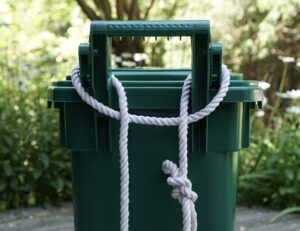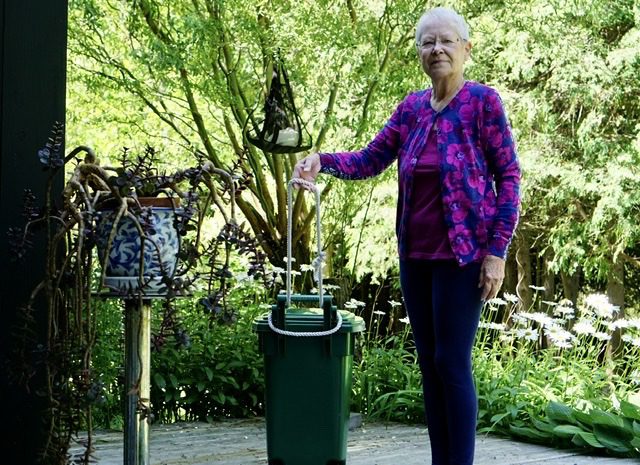by Rachel Everett-Fry, Local Journalism Initiative Reporter
Sue Cotter of Glen Gables has come up with a genius and simple solution for anyone struggling to get their Green Bin down to the end of the laneway on Garbage Day.
Sue, like many others, noticed that in order to balance the weight of her Green Bin and pull it at the same time, she had to adopt a lop-sided stoop. Of this stoop, Sue notes that “there’s a muscle that doesn’t like that.” But Sue had a “flash” of inspiration, drawing on the method she uses to transport her garbage to the curb in winter-time involving a length of cotton cord.
She discovered that by tying a length of cotton cord into a loop, threading that loop under the handle, and then sliding the loop around the sides of the handle (as pictured), the weight of the Green Bin can be perfectly distributed and balanced. If one does the same loop in an overhand manner, the Green Bin becomes vulnerable to tipping and wobbling.

Soon after coming up with this contraption, Sue introduced the idea to a neighbour. She says that he was “ecstatic” to have a solution to the weekly lop-sided trek. Further, he “commented, since he regularly goes on walks in the neighbourhood, that people aren’t using these little green bins. Rarely does he see one on garbage day.” This simple rope addition can make the Green Bin much more user-friendly, and perhaps encourage wider adoption of the composting initiative. Following her neighbour’s positive reception, Sue realized this was “an idea that should be shared with a whole community.”
The cord contraption can be optimized by using specialized knots. While someone without a Girl Scouts background may have simply tied a “Granny Knot,” the left over right, left over right knot instinctual to most, Sue favours knots that lie flat, which can be loosened by a push together. The Reef Knot, for instance, is a right over left and under, left over right and under. Or the Surgeons Knot, which adds one more repetition to the Reef Knot.
Sue recommends a minimum of 70 inches of cord to use for the initial loop, more if you’re tall. Further, she recommends using a cotton cord with a fairly thick cordage. The softness and thickness prevent the rope from digging too much into one’s hands. However, a polyester rope or a thinner rope could be accommodated by using a plastic or tape shield as a handle.
Once the rope is set up, Sue says that “all the weight is transferred to the wheels, and some in the handle. You can stand up and walk with your back straight. Alleluia.”







